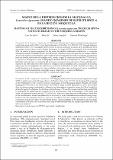Por favor, use este identificador para citar o enlazar este ítem:
https://hdl.handle.net/20.500.12958/3496| Título : | Mapeo de la distribución de la macroalga Lessonia nigrescens usando imágenes de satélite SPOT-6 en la Región Moquegua |
| Otros títulos : | Mapping of the distribution of Lessonia nigrescens through SPOT-6 satellite images in the Moquegua Region |
| Autor : | Escudero Herrera, Luis Xu, Han Atiquipa, Jaime Velaochaga, Germán |
| Palabras clave : | Lessonia nigrescens;Macroalgas;Imágenes satelitales;Moquegua |
| Fecha de publicación : | 2020 |
| Editorial : | Instituto del Mar del Perú |
| Citación : | Bol Inst Mar Perú. 35(2) 2020, p. 257-270 |
| Citación : | Boletín Imarpe;35(2), 2020 |
| Resumen : | Usando imágenes submétricas (SPOT-6) y realizando observaciones in situ se desarrolló el mapeo de la distribución de la macroalga Lessonia nigrescens en la Región Moquegua. La imagen SPOT-6 corresponde al 28 de setiembre 2018. Se realizó el preprocesamiento de los datos del satélite (calibración radiométrica y corrección
atmosférica usando el modelo QUAC) para obtener la reflectancia espectral para los tres canales visibles. A través del modelo de clasificación supervisada SVM se distinguieron los objetos que tienen característica espectral similar, tales como macroalgas, rocas, sombra y agua. Se estimó un área total de 3,777x104 m2 de L. nigrescens a lo largo de la costa de Moquegua, donde el 80% de la distribución se encuentra a partir de
Jaboncillo hacia al norte en ambientes del intermareal rocoso en forma de franjas. El área estimada de L. nigrescens por este trabajo fue 38,5% menor al comparar con los resultados de la evaluación de la misma especie por los investigadores del laboratorio costero de Ilo-IMARPE en 2014. Mediante el análisis del perfil latitudinal y al comparar los datos satelitales con lo observado se determinó la poca variabilidad espacial de la distribución de las macroalgas que se concentran en la zona los Platanales. ABSTRACT: We developed the mapping of the distribution of the Lessonia nigrescens macroalgae in the Moquegua Region through sub metric imaging (SPOT-6) and in situ observations. The SPOT-6 image is dated September 28, 2018. The satellite data was pre-processed (radiometric calibration and atmospheric correction using the QUAC model) to obtain the spectral reflectance for the three visible channels. We used the supervised learning model SVM to distinguish the objects that have similar spectral characteristics, such as macroalgae, rocks, shade, and water. We estimated a total area of 3,777x104 m2 of L. nigrescens along the coast of Moquegua, where 80% of the distribution is found from Jaboncillo to the north, in rocky intertidal environments forming strips. In this work, the estimated area of L. nigrescens was 38.5% less when compared with the results of the evaluation carried out in 2014. We determined the low spatial variability of the distribution of macroalgae concentrated in the area of Platanales by analyzing the latitudinal profile and comparing satellite data with what was observed. |
| URI : | https://hdl.handle.net/20.500.12958/3496 |
| ISSN : | 04587766 |
| Aparece en las colecciones: | Boletín 35(2), 2020 |
Ficheros en este ítem:
| Fichero | Descripción | Tamaño | Formato | |
|---|---|---|---|---|
| Bol 35(2)-5.pdf | 5,03 MB | Adobe PDF |  Visualizar/Abrir |
Este ítem está sujeto a una licencia Creative Commons Licencia Creative Commons

